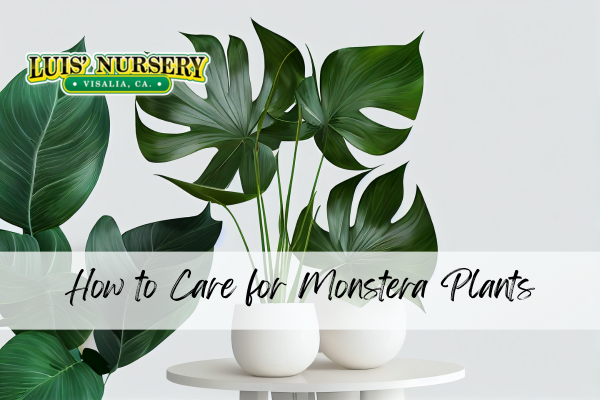Monstera plants have become popular over the past few years in both indoor gardening and home décor. The Monstera deliciosa, which is often referred to as the Swiss cheese plant, is the most recognizable of the Monstera genus. Did you know there are over 50 different species of Monstera plants? We would love to help you get to know the entire family and share some care tips to keep those Monsteras happy and healthy.
Monstera plants are native to Central and South America and are low-maintenance plant, easy to care for plants.
What are some types of Monstera?
1. Monstera deliciosa var borsigiana ‘albo-variegata’
This variegated species is known for its unique leaf patterns with each leaf having white bands that contrasts its green foliage. It is sensitive to strong sunlight and easily burnt due to its highly coveted contrasting designs.
2. Monstera deliciosa
The most recognizable and popular of the Monstera species it is known for its leaves full of fenestrations, or holes. These holes are why it’s often called a Swiss cheese plant. It loves to climb and will often create long cord-like roots from the stems.
3. Monstera deliciosa ‘Thai Constellation’
This cultivar was discovered in Thailand and is a sought out Monstera by collectors. The foliage is speckled and splashed and makes a gorgeous tropical houseplant.
4. Monstera adansonii
This monstera is known to be vigorous and fast growing. It has vining stems with smaller leaves that have large holes. They are easy to grow and propagate.
How do you propagate a Monstera?
Speaking of propagation, Monsteras are great candidates. The first step is to cut a piece of the plant below the node, which is the little ridge on the stem. Choose a stem that has at least one healthy leaf. Place the cutting in a clear glass of water until it roots, changing the water weekly. You may also choose to skip this step and plant it directly in the soil. Propagation can be done in a multiple of methods such as water or soil propagation, air layering or root division.
What type of care does a Monstera need?
1. Fertilizer – Monsteras are happy when you show them a little love by adding some fertilizer to their care routine. Fertilizer helps your monstera to create the foliage that they are loved for. You can use any houseplant fertilizer, but dilute it 50% and apply once a month, and even less in the winter when the plant growth slows.
2. Light – Monstera prefer filtered light over full sunlight and will become leggy if exposed to medium to low light conditions. Depending on the variety they can be forgiving with the amount of sunlight they are exposed to.
3. Soil – These plants prefer well-drained organic soil. Add the charcoal, bark, or perlite to the potting mix to create the best environment for your plants roots system. They enjoy air around their roots and good drainage.
4. Water – Monstera are a bit like Goldilocks – they don’t want it too wet, but they also don’t want to be too dry. To avoid root rot, wait for the top 1/3 to 1/4 inch of the soil to dry prior to watering. Don’t wait for your plant to start begging for water or this can cause leaves to yellow and fall.
5. Temperature and Humidity – Monstera prefer temperatures above 60 degrees. If they are too cold, they will slow down and if are too hot they can become stressed out. They do appreciate moderate to high humidity based on the tropical environment they are native to. If the humidity is too low, they will get brown leaves and pests. Mist the leaves and roots daily and consider elevating the pot above a saucer of water.
We hope that these simple tips will help you to have a healthy and happy Monstera! If you’re looking for your new plant, come on by, we are happy to help at Luis Nursery.



